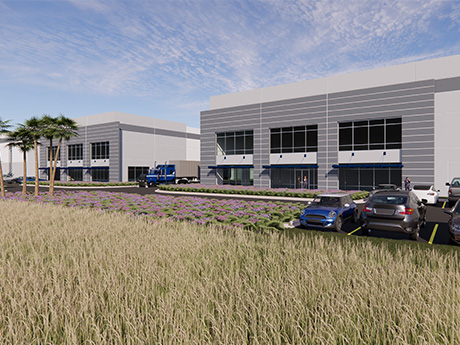Orlando’s industrial market continues to maintain strong market fundamentals. Despite leasing activity temporarily softening at the midway point of 2023 compared to the end of second-quarter 2022, exceptionally low vacancy rates persist, putting upward pressure on asking rental rates and further strengthening developer confidence in the market. With its strategic locational advantages and diverse tenant mix, the sector is well-positioned for future growth.

According to Florida Commerce, Orlando’s unemployment rate is 2.6 percent, well below the national rate of 3.6 percent. Labor shortages remain, as jobs increased by 5,300 in the industrial-using sector and 6,200 in trade, transportation, and utilities. At the same time, Central Florida’s population growth — along with the state’s business-friendly conditions, from no state income tax to relative affordability — consistently spurs demand for e-commerce logistics and warehousing throughout the region.
Asking rates surge
Year-to-date industrial leasing volume in Orlando has been 4.4 million square feet, 2.4 million square feet of which was in the second quarter. Total vacancy stood at 3.5 percent in the second quarter, significantly lower than the national vacancy rate of 5.4 percent. The average asking rate for industrial properties in Orlando was $10.77 triple-net per square foot, reflecting a 5.4 percent increase from 2022.
The market has historically experienced robust tenant demand and limited availability, resulting in a surge in average asking rents. However, by the end of the second quarter, industrial leasing activity experienced a significant decline of 48.2 percent compared to the record high recorded 12 months prior.
Ten lease transactions over 60,000 square feet were signed so far in 2023, with new leases dominating the activity. The largest was the 291,875-square-foot lease in Osceola County that Performance Food Group signed in the first quarter, followed by the 150,150-square-foot Assa Abloy lease and the 142,737-square-foot Quirch Foods lease, both signed in the Orlando Central Park submarket in the second quarter. Orlando Central Park and Osceola County saw the most activity, recording combined year-to-date absorption of 1.03 million square feet, which accounts for 61.7 percent of the overall market’s total year-to-date absorption.
Larger-sized lease transactions have slowed down in 2023, with some bulk spaces coming back on line as subleases. Smaller users show much larger growth potential, with landlords seeing opportunities to command higher rents in the $13 to $14 per square foot range for smaller spaces. Food distribution and construction-related companies represent most of the activity in the market.
Considering pre-pandemic levels and economic challenges, leasing remains relatively strong. There are no indications of rental rates softening in the near future. In fact, with new industrial inventory to be delivered this year, more rental rate increases are expected.
Record level of development
Developers continue to show strong confidence in Orlando’s industrial market. By the end of the second quarter, 2.2 million square feet of industrial space had been delivered, with 5.4 million square feet still under construction, signaling ongoing market growth. Additionally, another 4.5 million square feet will likely be delivered before the year’s end. This will set a new record for the highest amount of industrial space delivered in a single year, totaling 6.8 million square feet.
As of second-quarter, Blue Steel Development’s Apopka 429 industrial campus in the Northwest submarket has the three largest projects under development, which are Building 300 at 1.2 million square feet, Building 400 at 725,040 square feet and Building 200 at 576,160 square feet. All are expected to be delivered in September, and no preleases have been signed.
With 3.5 million square feet under construction, the Northwest submarket accounts for the largest amount of new industrial development. Little availability of quality land sites in high-demand areas like Airport-Southeast and Orlando Central Park, the two largest submarkets in terms of industrial inventory, has resulted in the need for industrial developers to build further out in sister cities like Apopka and Ocala.
Low investment inventory
Investor interest in the Orlando market remains strong as ever. However, there is very little inventory. Existing owners are holding on to properties because they risk paying high capital gains taxes with virtually nothing available to roll the sale proceeds into. With so much investor money in the market, high demand, and little supply, dwindling interest is not a concern.
Properties that do become available get traded very quickly at significant prices. The most notable industrial sale in 2023 in terms of total sale price was the I-4 Beltway Logistics Portfolio in the Longwood/Lake Mary/Sanford submarket, which sold for $65.2 million in the first quarter.
Buildings 100 and 200 at 280 General Electric Road in the Northwest sold for $40.2 million, and a three-property portfolio — including 503-553 West Grant Street in Northeast Orange County, 430-480 27th Street in Northeast Orange County and 10425 South Orange Avenue in the Airport-Southeast submarket — sold for $35.9 million in the second quarter.
Market outlook
As predicted, there was some slowdown in industrial leasing activity amid supply shortages, but new property deliveries will help ease short-term supply shortages across the market. Rents remain steady and are expected to increase, indicating confidence in the growing Orlando market.
— By Lisa Bailey, SIOR, Principal of Avison Young. This article was originally published in the August 2023 issue of Southeast Real Estate Business.


